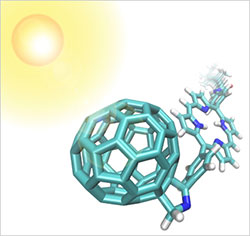Researchers Investigate Photosynthetic Materials

A triad molecule (left) is rendered in bond representation. Carbon atoms are in cyan, nitrogen in blue, and hydrogen in white.The article, Biologically Inspired Energy, featured on the Texas Advanced Computing Center’s (TACC) website, highlights Margaret Cheung’s use of the TACC’s Ranger supercomputer to investigate photosynthetic materials.
Cheung, an assistant professor of physics, is studying an artificial photosynthetic material, known as the carotenoid-prophyrin-C60 molecular triad, discovered in the 1990s by Devens Gust of Arizona State University. The material mimics the processes used by plants to get energy from the sun and converts sunlight into chemical energy.
“Right now, the molecule can only be controlled or contained in the lab,” Cheung said. Researchers in the Cheung lab are using computer simulations to determine how the size, temperature, and solvent in which the light-harvesting material is contained affect its ability to create energy. Through the simulations, she hopes to better understand the properties and behavior of the molecule, and gain some insight into improving it.
Cheung’s research is funded by the Department of Energy and results of her studies were published in the Journal of Physical Chemistry B in February. Her work uses advanced computers at TACC and the National Energy Research Scientific Computing Center.
Read more – Biologically Inspired Energy